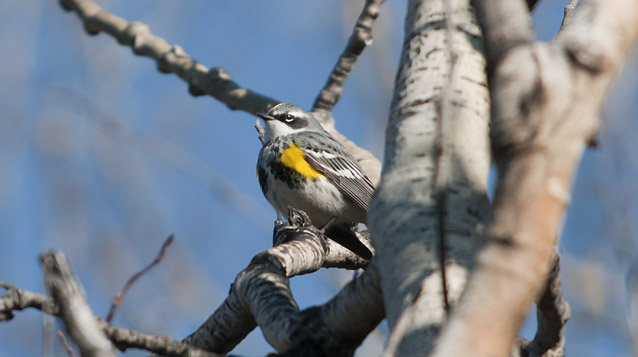
NPS Photo
Passerine birds (songbirds) are a vital sign of the National Park Service (NPS) Central Alaska Monitoring Network (CAKN). Since the early 1990s, NPS has collected data to document changes in abundance and distribution of songbirds in Denali. This has resulted in one of the longest running monitoring programs for these species in interior Alaska.
NPS scientists have used these data to:
- Document changes in the abundance of several species including Wilson’s Warbler and Fox Sparrow (see Schmidt et al. 2012).
- Identify shifts in the distribution of other species including Arctic Warbler, Savannah Sparrow and Golden-crowned Sparrow in relation to observed changes in the distribution of vegetation communities (see Mizel et al. 2016).
- Examine how changes in dates of first detection and peak detection relate to weather and climate.
The team collects data every year along a series of standardized surveys on the Denali Park Road, McCarthy Road, Nabesna Road and in off-road areas in Denali, Wrangell-St. Elias National Park and Preserve, and Yukon-Charley Rivers National Preserve. Our survey methods are like those used by the North American Breeding Bird Survey (BBS). The biggest difference is that we survey each sampling point at least three times each year and our surveys extend across the breeding season. Our repeat survey design allows us to conduct surveys for early nesting species including Boreal Chickadee and Ruby-crowned Kinglet as well as late arriving migrants including Alder Flycatcher and Arctic Warbler.
Surveys start about ½ hour before sunrise and take five to six hours to complete. At each sampling site, we record all the species we detect during a three-minute survey. We also record how and when we detected each bird, and a series of environmental variables such as weather conditions, insect levels, and background noise.
Surveys start about half an hour before sunrise and take five to six hours to complete. At each sampling site, we record all the species we detect during a three-minute survey. We also record how and when we detected each bird, and a series of environmental variables such as weather conditions, insect levels, and background noise.
2015 Update
In 2015, the team surveyed the routes 6 to 14 times between April 9th and June 30th. The number of species detected on each route ranged from 42 to 60, with the most species detected on the Nebesna Road in Wrangell-St. Elias (n = 60 species) and route 3 along the Denali Park Road (n = 52 species). We detected 98 species across all routes. White-crowned Sparrow was the most detected species on all roadside routes in Denali. We continued to detect singing male Tennessee Warblers along the McCarthy Road, and Camp Denali staff found a dead female Tennessee Warbler in the Camp Denali driveway in early June 2015. We also detected a singing male Eastern Phoebe along the Nabesna Road on 14 June 2015. Road-based surveys will continue in Denali and Wrangell-St. Elias in 2016. We will also pilot some off-road sampling techniques in the Primrose and Sable areas in 2016.
More Information
- Schmidt, J.H., C.L. McIntyre, and M.C. MacCluskie. 2013. Accounting for incomplete detection: What are we estimating and how might it affect long-term passerine monitoring programs. Biological Conservation 160:130-139.
- Mizel, J. D., J. H. Schmidt, C. L. Mcintyre, and C. A. Roland. 2016. Rapidly shifting elevational distributions of passerine species parallel vegetation change in the subarctic. Ecosphere 7(3):e01264. 10.1002/ecs2.1264.
- Mcintyre C. L. and Others. 2015. Monitoring passerine birds in the Central Alaska Monitoring Network: 2013 - 2014 annual progress report for the Central Alaska Vital Signs Monitoring Program. Natural Resource Data Series. NPS/CAKN/NRDS—2015/964. National Park Service. Fort Collins, Colorado. https://irma.nps.gov/DataStore/Reference/Profile/2223709
Last updated: April 20, 2016
